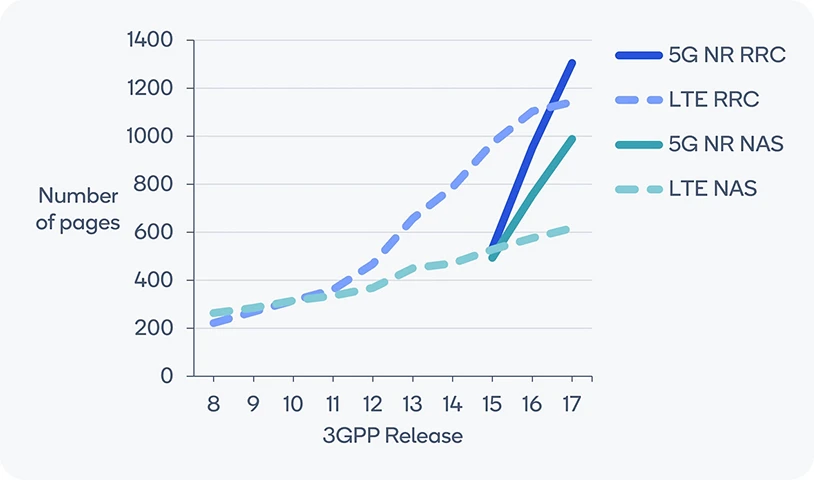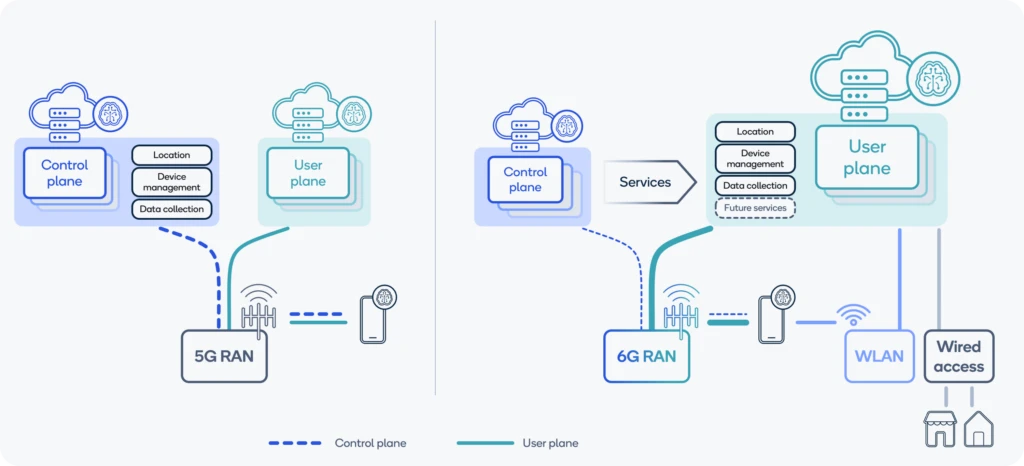As we prepare for the next generation of wireless connectivity, we’re building on everything we’ve learned.
Welcome to the first installment of 6G Foundry, a new exclusive series of OnQ blog posts exploring the next generation of wireless connectivity. We discuss how lessons learned from current and previous generations of mobile communications technology can be applied to form more efficient and flexible networks for the future. Today, we look at the evolution of network control and the development of the logical channels used to carry control traffic (the control plane).

The 4G and 5G user plane stacks reflect the “hourglass model” of the internet.
How far has 5G come and how did we get here?
The evolution to 6G originated with the convergence of two separate systems: data networks (the Internet) and cellular networks (2G). These networks originally had different design paradigms. Data networks were built to scale and accommodate heterogeneous devices for a variety of services, while cellular networks were designed for homogeneous devices for a single service, primarily voice communications.
The advent of smartphones, combined with the adoption of the “hourglass model” of the Internet as a design driver for data connectivity, played a major role in the success of 4G. By supporting IP in the user plane, 4G connected mobile devices (such as smartphones) to the Internet and revolutionized how the world communicates. However, the architecture and design philosophy introduced with 3G, including a separate control plane, was largely retained in 4G and later 5G.
Although 4G adopted the IP model for the user plane, it continued to rely on a separate control plane, as first introduced in 3G. The control plane’s Non-Access Stratum (NAS) and Radio Resource Control (RRC) protocols grew more complex as more services were added with each 3GPP release.
As 4G evolved, new features were introduced that extended the capabilities of the system, leading to the expansion of the control plane. Some of the complexity was required to support new horizontal capabilities on the link such as carrier aggregation and dual connectivity, and additional support for new verticals such as the Internet of Things (IoT) and vehicle-to-vehicle (V2X) was defined. However, other features were also introduced in the protocol stack to allow services to be hosted as part of the NAS/RRC control plane protocols. For example, NAS protocol services include location information, and RRC protocol services include data collection such as Minimization of Drive Testing (MDT).
“Deploying new control plane services is challenging because they often impact many different network entities.”
Services over NAS or RRC also require expertise to develop, deploy, test and maintain compared to more mainstream IP-based services. Although the control plane feature set has become richer, its adoption is still limited due to its impact on existing network entities. This creates challenges for new market entrants who want to develop these services, as well as for operators who want to deploy these services, and also creates additional costs for upgrading legacy infrastructure.
One of the key themes of the 5G standard that was a step in the right direction was the Service Based Architecture (SBA). The 5G SBA replaced complex and domain-specific protocols such as GTP-C with mainstream protocols such as HTTP/2 for transport and JavaScript Object Notation (JSON) as the serialization protocol. However, while this was a paradigm shift, it only applied to core network entities and did not benefit network services involving user devices (UEs).
As the transition from 4G to 5G progresses, we see that 5G follows much the same trajectory as its predecessor. 5G’s NAS and RRC protocol stacks have become more complex. Though the feature set has expanded significantly, adoption of control plane services remains sparse. The limited success of 5G-based control plane services is creating obstacles for operators who want to address promising new business opportunities.

Control plane growth as 3GPP standards evolve.
An important step towards 6G development
To overcome these challenges, we propose a user-plane-first design approach for 6G, enabling unified access to services. At the heart of the user-plane-first design approach is a lean control plane that addresses only those aspects essential for maintaining connectivity and establishing data services, such as security, mobility, and session management. This simplifies the architecture and enables operators to deploy and operate services more efficiently.
“In the 6G network architecture, services such as location information, data collection, industrial IoT and other future 6G services are likely to run as IP-based services over the user plane.”
This approach benefits from the scale and ecosystem of Internet services and protocols, broadens the development environment for network services, and simplifies service deployment and operation, benefiting both operators and users.
Additionally, this user plane first design approach is a natural fit with new cloud-based deployments, eliminating the need for additional hardware, and enables “G agnostic” services that work seamlessly across different generations of cellular networks. It also enables services to be backported to previous generations or crossported to other wireless technologies, such as Wi-Fi networks, and wired access technologies, such as fiber optics and cable.

User plane service prioritization and an efficient control plane improve service adoption.
What does the future hold for 6G technology?
As we embark on the journey to 6G, it is essential to learn from the past and adopt a new approach to network architecture design. By adopting a user-plane-first design strategy for network services and leveraging Internet design principles, we can build more efficient, scalable, and innovative 6G networks.
In upcoming 6G Foundry blog posts, we will go into more detail about how 6G networks will be deployed and how new experiences will bring value to end users. Join us as we unlock the possibilities of wireless connectivity and shape the future. Stay tuned for the next 6G Foundry article.
Subscribe to the Wireless Technology Newsletter
Follow us on X


